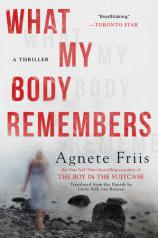What My Body Remembers
Review
What My Body Remembers
The name Agnete Friis should be familiar to mystery readers, particularly those with an interest in Nordic noir. Friis has co-authored with Lene Kaaberbøl the critically acclaimed and commercially popular quartet of Nina Borg mystery novels over the past several years. WHAT MY BODY REMEMBERS marks Friis’ solo debut as an author --- ably assisted with translation by Lindy Falk van Rooyen --- with a dark and disturbing tale that is primarily a social study and cautionary piece with an underpinning mystery. It is not an experience that one is likely to forget easily.
The book is narrated primarily by Ella Nygaard, who has been a ward of the state for the two decades following the violent death of her mother. Such would be a traumatic event for anyone at any age, but particularly so for a seven-year-old girl. With her father sent to prison following the murder, Ella’s childhood consisted of violent outbursts that resulted in her being shunted off to family after family until she reached her majority. By that time she had a son, Alex, who is 12 years old in the “now” of the tale. Ella is in her late 20s and has succumbed to alcoholism, almost totally unemployable and reduced to a monthly check from the Danish welfare state for income, supplemented by returning bottles for cash. The alcoholism is a form of self-medication for Ella, given that she experiences panic attacks that leave her incapacitated for hours, even days, and physically and emotionally empty.
"The mystery that constitutes the foundation of WHAT MY BODY REMEMBERS will be the initial attraction for the reader, but the ultimate reason to remain with the book is Friis’ demonstrated ability to explore and investigate the social problems arising from substance abuse..."
Ella experiences one of these attacks shortly after her introduction in WHAT MY BODY REMEMBERS, and her subsequent hospitalization in a psychiatric ward results in Alex being placed on an indeterminate full-time basis with his occasional foster family. Ella does not number self-control among her few remaining assets. She removes Alex from the home without authorization and flees with him to the one place where she probably shouldn’t go: her childhood hometown in northern Denmark. Ella and Alex move into her paternal grandmother’s dilapidated and abandoned home, hoping that the Danish bureaucracy will keep itself at bay while she tries to get her life back on track.
Ella’s homecoming is anything but pleasant, though, and a series of intermittent vignettes that slowly lead up to the violent passing of her mother demonstrates why. Her need for alcohol doesn’t help matters, of course, particularly when it comes to dealing with Thomas, a man who insists that he and Ella were childhood friends, and Barbara, an older woman whose aggressive friendliness has a sharp edge as she gradually insinuates herself into Ella’s life. As the reader learns what occurs during Ella’s childhood, her present life seems to spiral further out of control as she slowly but inexorably learns the truth about her mother and father, and the events that led up to the night that changed her life for the worse and are quickly intruding into her present as well.
The mystery that constitutes the foundation of WHAT MY BODY REMEMBERS will be the initial attraction for the reader, but the ultimate reason to remain with the book is Friis’ demonstrated ability to explore and investigate the social problems arising from substance abuse both as a gateway to personal destruction and as a coping mechanism, however dubiously. Her presentation of such matters through her characters, particularly Ella and Ella’s circle of friends, is sobering on several levels. Those whose use of substances might be approaching levels that exceed recreational limits may see themselves in this book and consider their practices, even as they may well view any uninvited, friendly approaches from incessant strangers with a jaundiced eye.
Whether one wishes to characterize WHAT MY BODY REMEMBERS as Friis’ first solo effort or as a branch of a collaborative work, this latest addition to her shelf is indeed impressive.
Reviewed by Joe Hartlaub on May 19, 2017





